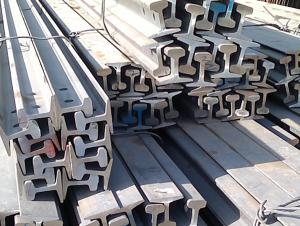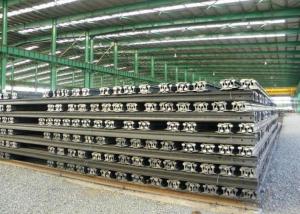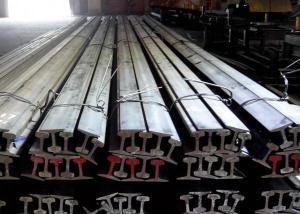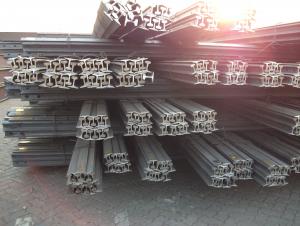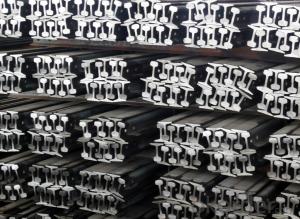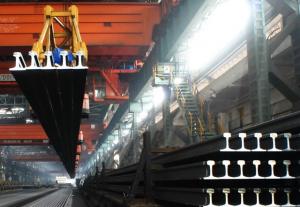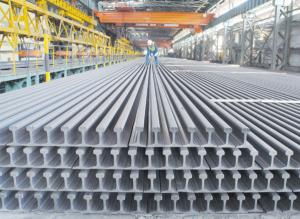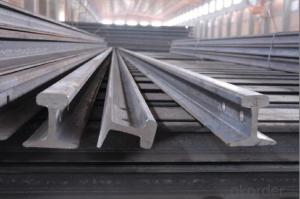Steel Heavy Rail 50MN, U71MN, 900A, 110A
- Loading Port:
- China main port
- Payment Terms:
- TT or LC
- Min Order Qty:
- 25 m.t.
- Supply Capability:
- 100000 m.t./month
OKorder Service Pledge
OKorder Financial Service
You Might Also Like
Product Description of Steel Heavy Rail 50MN, U71MN, 900A, 110A:
Sizes: 38kg, 43kg, 45kg, 50kg, 60kg.
Production Standard: GB2585-81, DIN, AREMA, JIS, BS, UIC, etc.
Material: 50MN, U71MN, 900A, 110A, etc.
Length: 6m-25m according to the requriements of the clients
Usages of Steel Heavy Rail 50MN, U71MN, 900A, 110A:
Light rail is mainly used in forest region, mines, factories and construction sites laid of the place such as temporary transport line and light motorcycles with line. Be widely used for railway, subway, transportation track, express, curve way, tunnel way and so on.
Packaging & Delivery of Steel Heavy Rail 50MN, U71MN, 900A, 110A:
1. Packing: it is nude packed in bundles by steel wire rod
2. Bundle weight: not more than 3.5MT for bulk vessel; less than 3 MT for container load
3. Marks:
Color marking: There will be color marking on both end of the bundle for the cargo delivered by bulk vessel. That makes it easily to distinguish at the destination port.
Tag mark: there will be tag mark tied up on the bundles. The information usually including supplier logo and name, product name, made in China, shipping marks and other information request by the customer.
If loading by container the marking is not needed, but we will prepare it as customer request.
4. Transportation: the goods are delivered by truck from mill to loading port, the maximum quantity can be loaded is around 40MTs by each truck. If the order quantity cannot reach the full truck loaded, the transportation cost per ton will be little higher than full load.
5. Delivered by container or bulk vessel
6. Delivery Time: All the Hot Rolled Steel Rail will be transpoted at the port of Tianjin, China within 30 days after receiving the advance payment by T/T or the orginal L/C at sight.
Inspection of Steel Heavy Rail 50MN, U71MN, 900A, 110A:
We will send the MTC of the factory to the clients dirrectly which contain the anlisis of the heat, chemiqul composition, phisical characteristicas, etc.
And our inspectors will arrive at the factory to meke the inspection of the size, length, weight and quantity before the transportation from the factory.
FAQ:
Q1: Why buy Materials & Equipment from OKorder.com?
A1: All products offered by OKorder.com are carefully selected from China's most reliable manufacturing enterprises. Through its ISO certifications, OKorder.com adheres to the highest standards and a commitment to supply chain safety and customer satisfaction.
Q2: What makes stainless steel stainless?
A2: Stainless steel must contain at least 10.5 % chromium. It is this element that reacts with the oxygen in the air to form a complex chrome-oxide surface layer that is invisible but strong enough to prevent further oxygen from "staining" (rusting) the surface. Higher levels of chromium and the addition of other alloying elements such as nickel and molybdenum enhance this surface layer and improve the corrosion resistance of the stainless material.
Q3: Can stainless steel rust?
A3: Stainless does not "rust" as you think of regular steel rusting with a red oxide on the surface that flakes off. If you see red rust it is probably due to some iron particles that have contaminated the surface of the stainless steel and it is these iron particles that are rusting. Look at the source of the rusting and see if you can remove it from the surface.
Images:
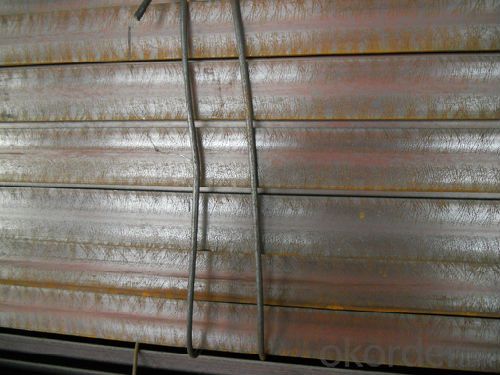
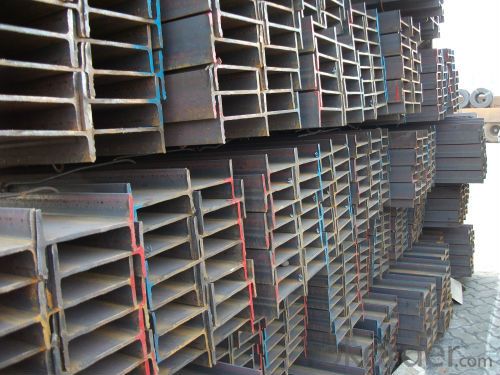
- Q:What is the impact of steel rails on train fuel efficiency?
- The impact of steel rails on train fuel efficiency is significant and positive. Steel rails provide a smooth and stable surface for the train wheels to roll on, reducing friction and resistance. This, in turn, allows trains to move more efficiently and at higher speeds. The reduced friction between the steel rails and train wheels results in less energy wasted and ultimately leads to lower fuel consumption. Compared to other materials, such as wooden or concrete rails, steel rails offer superior durability and strength. They can withstand heavy loads and maintain their shape and integrity over long distances and extended periods of time. This durability ensures that the train remains on a stable track, minimizing the need for frequent repairs or adjustments. As a result, the train can maintain its momentum and consume less fuel in the process. Furthermore, steel rails have a low coefficient of thermal expansion, meaning they do not expand or contract significantly with temperature changes. This characteristic allows for a more consistent and reliable track alignment, reducing the need for constant realignment and maintenance. The stable track alignment ensures that the train can travel efficiently without unnecessary energy losses due to misalignment or track irregularities. In addition to improving fuel efficiency, steel rails also contribute to overall safety and reliability in train transportation. Their strength and durability help prevent derailments and accidents, ensuring the safety of passengers and cargo. By providing a stable and secure track, steel rails also minimize the risk of train delays and disruptions, enhancing the reliability and punctuality of train services. In conclusion, the impact of steel rails on train fuel efficiency is highly positive. The smooth and stable surface provided by steel rails reduces friction and resistance, allowing trains to move more efficiently and consume less fuel. The durability of steel rails ensures a consistent track alignment, minimizing the need for repairs and maintenance, further optimizing fuel efficiency. Overall, steel rails contribute to safer, more reliable, and environmentally friendly train transportation.
- Q:How are steel rails protected from electrical interference?
- The process of bonding protects steel rails from electrical interference. Bonding involves establishing a low-resistance electrical connection between different metal components, such as steel rails, in order to eliminate any potential differences in electrical potential. To safeguard against electrical interference, bonding cables or wires are installed at regular intervals along the rail tracks. These cables or wires are typically constructed from copper or other highly conductive materials. They are securely attached to the steel rails using specialized clamps or welded joints. The presence of bonding cables forms a continuous electrical path along the rail tracks, ensuring the swift and efficient dispersion of any electrical current or interference. By creating a low-resistance route, the bonding cables help prevent the accumulation of electrical potential differences between various sections of the rail tracks, thereby minimizing the risk of electrical interference. Moreover, the bonding cables also serve another important purpose: they contribute to the reduction of electrical shock hazards for railway personnel and passengers. By establishing a continuous electrical connection, any stray electrical currents or faults are safely redirected away from the steel rails and into the grounding system, thereby preventing potential harm to individuals in close proximity to the tracks. In conclusion, bonding is a vital technique for shielding steel rails from electrical interference. It ensures the secure and efficient operation of railway systems by effectively dispersing electrical currents and mitigating potential hazards associated with electrical interference.
- Q:What is the cause of the side or rail end of the rail? If not timely remediation, what will easily lead to consequences?
- Simple and straightforward to say: rail by lateral, vertical long-term pressure fatigue, make rail deformation deformation, so that the profile of horizontal widening, that is, fat edge.
- Q:Are there any safety regulations specific to steel rails?
- Yes, there are safety regulations specific to steel rails. These regulations are put in place to ensure the safe operation and maintenance of railway systems. Some of the key safety regulations specific to steel rails include: 1. Rail profile standards: Safety regulations specify the dimensions and profile of steel rails, ensuring they meet certain standards to ensure stability and prevent derailments. 2. Rail inspection and maintenance: Safety regulations require regular inspections of steel rails to identify any defects or damage, such as cracks, corrosion, or excessive wear. Maintenance procedures are also established to address these issues promptly and prevent accidents. 3. Rail welding standards: Safety regulations outline specific standards for rail welding techniques to ensure the integrity and strength of rail joints. Proper welding is crucial to prevent rail fractures and ensure smooth train operations. 4. Rail fastening systems: Safety regulations dictate the design and installation of rail fastening systems, including bolts, clips, and other components that secure the rails to the sleepers or ties. These regulations aim to prevent rail movement or displacement, minimizing the risk of accidents. 5. Train speed limits: Safety regulations set maximum speed limits for trains on specific rail sections, considering factors like track condition, curvature, and gradient. These limits are established to ensure safe operations and prevent excessive stress or damage to steel rails. 6. Emergency response protocols: Safety regulations also include guidelines for emergency response in case of accidents or incidents involving steel rails. These protocols outline procedures for evacuation, securing the area, and coordinating with emergency services to minimize injury and damage. Overall, safety regulations specific to steel rails play a vital role in ensuring the safe and efficient functioning of railway systems. They help prevent accidents, ensure the longevity of rails, and safeguard the well-being of passengers, crew, and surrounding communities.
- Q:How are steel rails protected against vandalism and theft?
- Steel rails are protected against vandalism and theft through various measures such as regular patrols by security personnel, installation of surveillance cameras along the rail lines, and implementing secure fencing around rail yards. Additionally, advanced technologies like track circuitry and alarms are used to detect any tampering or unauthorized access to the rail infrastructure.
- Q:What is the rail of the railway?
- So people use manganese steel to make wear-resistant machine parts and rails, bridges and so on
- Q:What is the role of ballast in supporting steel rails?
- The role of ballast in supporting steel rails is to provide stability and distribute the weight of the rails and trains evenly across the track. It helps to prevent the rails from sinking into the ground or shifting under the weight of passing trains, ensuring a safe and reliable track structure.
- Q:How are steel rails protected against chemical corrosion?
- Steel rails are protected against chemical corrosion through a process called galvanization, where a layer of zinc is applied to the surface of the rails. This zinc layer acts as a sacrificial coating, preventing the steel from coming into direct contact with corrosive chemicals or moisture, thereby prolonging the lifespan of the rails. Additionally, regular maintenance and inspection are carried out to identify and address any signs of corrosion in a timely manner.
- Q:Can steel rails be used for mountain or alpine railways?
- Yes, steel rails can be used for mountain or alpine railways. Steel is a strong and durable material that is commonly used for railway tracks in various terrains, including mountainous and alpine regions. Its strength allows it to withstand the weight and pressure of heavy trains and provide a stable and safe track for railway operations in challenging landscapes.
- Q:What are the challenges of maintaining steel rails in remote areas?
- The challenges of maintaining steel rails in remote areas include limited accessibility, lack of infrastructure, harsh weather conditions, and difficulty in transporting equipment and resources.
1. Manufacturer Overview |
|
|---|---|
| Location | |
| Year Established | |
| Annual Output Value | |
| Main Markets | |
| Company Certifications | |
2. Manufacturer Certificates |
|
|---|---|
| a) Certification Name | |
| Range | |
| Reference | |
| Validity Period | |
3. Manufacturer Capability |
|
|---|---|
| a)Trade Capacity | |
| Nearest Port | |
| Export Percentage | |
| No.of Employees in Trade Department | |
| Language Spoken: | |
| b)Factory Information | |
| Factory Size: | |
| No. of Production Lines | |
| Contract Manufacturing | |
| Product Price Range | |
Send your message to us
Steel Heavy Rail 50MN, U71MN, 900A, 110A
- Loading Port:
- China main port
- Payment Terms:
- TT or LC
- Min Order Qty:
- 25 m.t.
- Supply Capability:
- 100000 m.t./month
OKorder Service Pledge
OKorder Financial Service
Similar products
New products
Hot products
Related keywords
